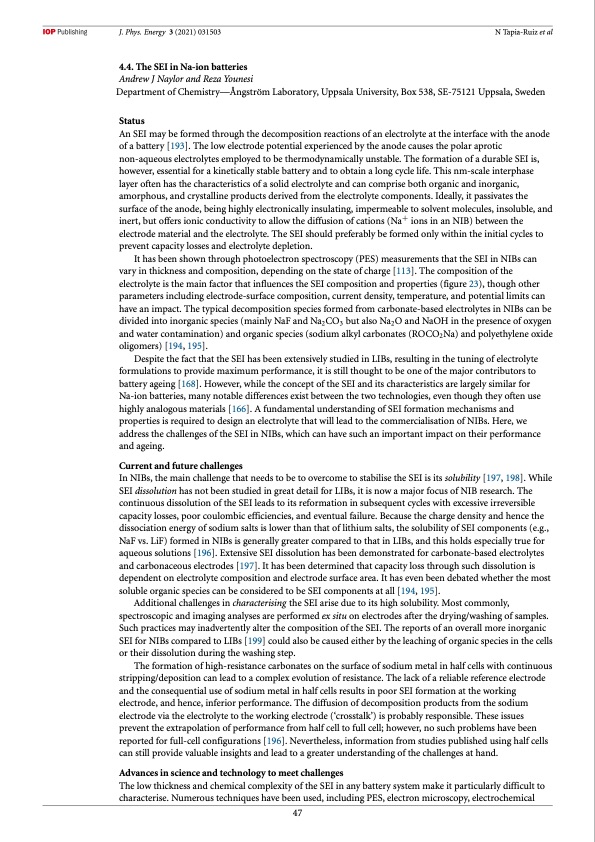
PDF Publication Title:
Text from PDF Page: 048
J. Phys. Energy 3 (2021) 031503 N Tapia-Ruiz et al 4.4. The SEI in Na-ion batteries Andrew J Naylor and Reza Younesi Department of Chemistry—Ångström Laboratory, Uppsala University, Box 538, SE-75121 Uppsala, Sweden Status An SEI may be formed through the decomposition reactions of an electrolyte at the interface with the anode of a battery [193]. The low electrode potential experienced by the anode causes the polar aprotic non-aqueous electrolytes employed to be thermodynamically unstable. The formation of a durable SEI is, however, essential for a kinetically stable battery and to obtain a long cycle life. This nm-scale interphase layer often has the characteristics of a solid electrolyte and can comprise both organic and inorganic, amorphous, and crystalline products derived from the electrolyte components. Ideally, it passivates the surface of the anode, being highly electronically insulating, impermeable to solvent molecules, insoluble, and inert, but offers ionic conductivity to allow the diffusion of cations (Na+ ions in an NIB) between the electrode material and the electrolyte. The SEI should preferably be formed only within the initial cycles to prevent capacity losses and electrolyte depletion. It has been shown through photoelectron spectroscopy (PES) measurements that the SEI in NIBs can vary in thickness and composition, depending on the state of charge [113]. The composition of the electrolyte is the main factor that influences the SEI composition and properties (figure 23), though other parameters including electrode-surface composition, current density, temperature, and potential limits can have an impact. The typical decomposition species formed from carbonate-based electrolytes in NIBs can be divided into inorganic species (mainly NaF and Na2CO3 but also Na2O and NaOH in the presence of oxygen and water contamination) and organic species (sodium alkyl carbonates (ROCO2Na) and polyethylene oxide oligomers) [194, 195]. Despite the fact that the SEI has been extensively studied in LIBs, resulting in the tuning of electrolyte formulations to provide maximum performance, it is still thought to be one of the major contributors to battery ageing [168]. However, while the concept of the SEI and its characteristics are largely similar for Na-ion batteries, many notable differences exist between the two technologies, even though they often use highly analogous materials [166]. A fundamental understanding of SEI formation mechanisms and properties is required to design an electrolyte that will lead to the commercialisation of NIBs. Here, we address the challenges of the SEI in NIBs, which can have such an important impact on their performance and ageing. Current and future challenges In NIBs, the main challenge that needs to be to overcome to stabilise the SEI is its solubility [197, 198]. While SEI dissolution has not been studied in great detail for LIBs, it is now a major focus of NIB research. The continuous dissolution of the SEI leads to its reformation in subsequent cycles with excessive irreversible capacity losses, poor coulombic efficiencies, and eventual failure. Because the charge density and hence the dissociation energy of sodium salts is lower than that of lithium salts, the solubility of SEI components (e.g., NaF vs. LiF) formed in NIBs is generally greater compared to that in LIBs, and this holds especially true for aqueous solutions [196]. Extensive SEI dissolution has been demonstrated for carbonate-based electrolytes and carbonaceous electrodes [197]. It has been determined that capacity loss through such dissolution is dependent on electrolyte composition and electrode surface area. It has even been debated whether the most soluble organic species can be considered to be SEI components at all [194, 195]. Additional challenges in characterising the SEI arise due to its high solubility. Most commonly, spectroscopic and imaging analyses are performed ex situ on electrodes after the drying/washing of samples. Such practices may inadvertently alter the composition of the SEI. The reports of an overall more inorganic SEI for NIBs compared to LIBs [199] could also be caused either by the leaching of organic species in the cells or their dissolution during the washing step. The formation of high-resistance carbonates on the surface of sodium metal in half cells with continuous stripping/deposition can lead to a complex evolution of resistance. The lack of a reliable reference electrode and the consequential use of sodium metal in half cells results in poor SEI formation at the working electrode, and hence, inferior performance. The diffusion of decomposition products from the sodium electrode via the electrolyte to the working electrode (‘crosstalk’) is probably responsible. These issues prevent the extrapolation of performance from half cell to full cell; however, no such problems have been reported for full-cell configurations [196]. Nevertheless, information from studies published using half cells can still provide valuable insights and lead to a greater understanding of the challenges at hand. Advances in science and technology to meet challenges The low thickness and chemical complexity of the SEI in any battery system make it particularly difficult to characterise. Numerous techniques have been used, including PES, electron microscopy, electrochemical 47PDF Image | 2021 roadmap for sodium-ion batteries

PDF Search Title:
2021 roadmap for sodium-ion batteriesOriginal File Name Searched:
roadmap-sodium-ion-batteries_031503.pdfDIY PDF Search: Google It | Yahoo | Bing
Salgenx Redox Flow Battery Technology: Salt water flow battery technology with low cost and great energy density that can be used for power storage and thermal storage. Let us de-risk your production using our license. Our aqueous flow battery is less cost than Tesla Megapack and available faster. Redox flow battery. No membrane needed like with Vanadium, or Bromine. Salgenx flow battery
| CONTACT TEL: 608-238-6001 Email: greg@salgenx.com | RSS | AMP |